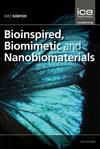田口设计聚乙烯醇(PVA)/阿拉伯胶(AG)/MgO纳米颗粒生物纳米复合材料漱口水抗菌性能研究
IF 0.6
4区 工程技术
Q4 ENGINEERING, BIOMEDICAL
引用次数: 0
摘要
未经治疗的龋齿是人类生活中的一个重要挑战。本工作合成了聚乙烯醇-阿拉伯树胶-氧化镁纳米复合材料,并对其对变形链球菌生物膜的体外抗菌性能进行了评价。为了优化具有最大抗菌性能的变量,采用田口法L9正交阵列设计了提取条件。通过X射线衍射(XRD)、场发射扫描电子显微镜(FESEM)、X射线能量衍射(EDS)、热重分析(TGA)和透射电子显微镜(TEM)测试对纳米复合材料进行了表征。纳米复合材料的FESEM图像抑制了纳米颗粒完全被基质的聚合物链包围,纳米颗粒沉积在其壁上,从而形成了层状纳米复合材料。纳米复合材料的片宽和尺寸范围在30-40和20-90之间确定 nm。结果表明,在1 mg/ml PVA,3 mg/ml AG和6 mg/ml MgO(实验3)对变形链球菌的生物膜具有最强的抗菌活性。在这种情况下,细菌存活率最低,为0.21 CFU/ml,在该最佳条件下对变形链球菌的抑制率为0.09 CFU/ml。本文章由计算机程序翻译,如有差异,请以英文原文为准。
Investigation of antibacterial activity of new bionanocomposite based on polyvinyl alcohol(PVA)/arabic gum(AG)/MgO nanoparticles by Taguchi design for mouthwash application
Untreated dental caries is an important word challenge in human life. In this work, we synthesized polyvinyl alcohol-gum arabic-magnesium oxide nanoparticles new bionanocomposite and evaluated the antibacterial properties of its against Streptococcus mutans biofilm in vitro. For optimization of variables to have the maximum antibacterial property, L9 orthogonal array of Taguchi method was used for design of extraction conditions. The nanocomposites were characterized by X-ray diffraction (XRD), field emission scanning electron microscopy (FESEM), X-ray energy diffraction (EDS), Thermogravimetric analysis (TGA) and transmission electron microscopy (TEM) tests. The FESEM images of nanocomposite inhibit that the nanoparticles are entirely surrounded with polymers chains of matrix and nanoparticles are deposited on the its walls, thus a layered nanocomposite is formed. The sheet width and size range of the nanocomposite was determined between 30-40 and 20-90 nm, respectively. The results showed that the synthesized nanocomposite with conditions of 1 mg/ml PVA, 3 mg/ml AG, and 6 mg/ml MgO (experiment 3), had the strongest antibacterial activity against the Streptococcus mutans bacteria’s biofilm. In this condition, the bacterial survival rate was the lowest at 0.21 CFU/ml and under this optimal conditions could inhibit the activity of Streptococcus mutans bacteria at a rate of 0.09 CFU/ml.
求助全文
通过发布文献求助,成功后即可免费获取论文全文。
去求助
来源期刊

Bioinspired Biomimetic and Nanobiomaterials
ENGINEERING, BIOMEDICAL-MATERIALS SCIENCE, BIOMATERIALS
CiteScore
2.20
自引率
0.00%
发文量
12
期刊介绍:
Bioinspired, biomimetic and nanobiomaterials are emerging as the most promising area of research within the area of biological materials science and engineering. The technological significance of this area is immense for applications as diverse as tissue engineering and drug delivery biosystems to biomimicked sensors and optical devices.
Bioinspired, Biomimetic and Nanobiomaterials provides a unique scholarly forum for discussion and reporting of structure sensitive functional properties of nature inspired materials.
 求助内容:
求助内容: 应助结果提醒方式:
应助结果提醒方式:


